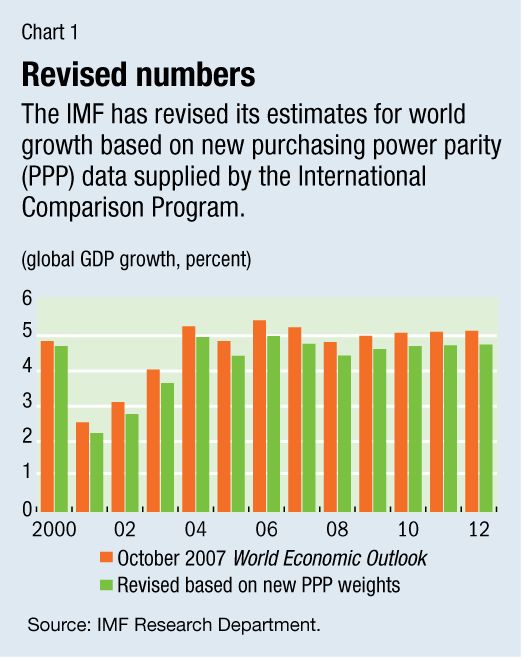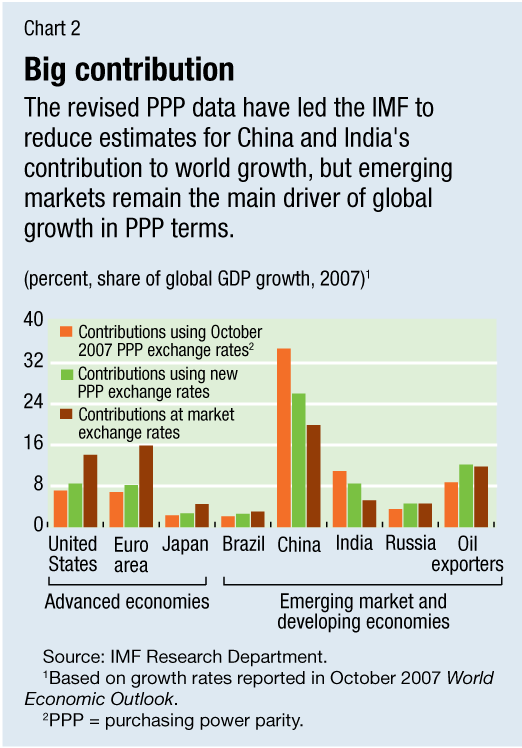INTERNATIONAL STATISTICAL COMPARISON

Typical street scene in Santa Ana, El Salvador. (Photo: iStock)
IMF Survey: Global Growth Estimates Trimmed After PPP Revisions
January 8, 2008
- New purchasing power parity estimates released by worldwide statistical project
- As a result, IMF adjusts down global growth estimates
- Emerging markets led by China remain the main driver of recent growth
Based on new statistical calculations of purchasing power parity (PPP) exchange rates published last month by the International Comparison Program (ICP), the IMF has revised downward its estimates for global growth by around ½ percentage point each year during 2002-07.

Worker checks slabs in Wuhan, China: country's world output share revised down by IMF after release of new PPPs by global statistics project (photo: EyePress)
For example, the IMF's estimate for global growth in 2007 has been revised down to 4.7 percent from 5.2 percent in the October 2007 World Economic Outlook (see Chart 1).
The IMF will update its forecast for global growth on January 25. The update will take account of these revised PPP estimates.
The IMF uses PPP exchange rates provided by the ICP as the basis for calculating the relative sizes of economies. The ICP revisions imply a substantial reduction in the PPP rates of some key emerging market countries and an upward revision in others (including oil exporters). The changes have implications for both aggregate global growth based on PPP exchange rates and the share of global GDP accounted for by individual countries and groups.

Downward revisions for PPP-based GDP of two of the world's fastest-growing economies, China and India, are mainly responsible for the overall reduction of global growth estimates (see Chart 2). For 2007, China's share of global output is now estimated at 10.9 percent (down from 15.8 percent) while India's share has declined to 4.6 percent (from 6.4 percent). Reflecting the overall reduction in GDP in PPP terms of other countries, the share of the United States in global GDP has been revised up from 19.3 percent to 21.4 percent.
Notwithstanding these changes, it remains true that emerging market countries have been the main recent driver of global growth in PPP terms—led by China, which alone contributed nearly 27 percent to global growth in 2007.
What the ICP does
The ICP project, coordinated by the World Bank, produces PPP estimates based on statistical surveys of price data for a basket of goods and services for 100 developing countries. The Eurostat-OECD PPP program provides estimates for another 46 countries. On December 17 last year, the ICP released preliminary PPP estimates for the 2005 benchmark year, replacing previous benchmark PPP estimates, which date back to 1993 or earlier for most emerging market and developing countries.
Why are PPP exchange rates important?
Purchasing power parity rates are an alternative way of calculating the exchange rate between countries based upon the comparison of prices of similar goods and services in different countries. The PPP rate is defined as the amount of currency that would be needed to purchase the same basket of goods and services as one unit of the reference currency, usually the U.S. dollar. The PPP rate can—especially in the short run—deviate by a large amount from the market exchange rate between two currencies, given the influence of trade, capital flows, and other factors on market exchange rates.

Another well-known but admittedly crude measure of the PPP exchange rate between countries is The Economist's Big Mac index, which calculates the exchange rate at which the eponymous hamburger would cost the same across all countries in the index. (For a fuller explanation, see article in March 2007 Finance and Development magazine, PPP Versus the Market: Which Weight Matters?)
PPP exchange rates are used in estimating aggregate economic activity across the world. Because they adjust for the difference in price levels across countries, they tend to lead to a more accurate estimate of global economic activity than simply using market exchange rates.
For example, developing countries typically have relatively low prices for nontraded goods and services, and a unit of local currency thus has greater purchasing power within a developing country than it does internationally. Whereas PPP-based GDP takes this into account, conversions based on market exchange rates typically underestimate the value of economic activity and output of a developing country relative to an advanced economy.
Even among advanced economies, PPP-based GDP estimates provide a more consistent picture of their contribution to aggregate economic activity as bilateral exchange rates can move sharply and distort individual countries' contributions to global economic activity.
Why are the new PPP estimates better?
The 2003-2007 ICP round that produced the 2005 estimates represents the most extensive and thorough effort ever to measure PPP rates across countries. New and innovative data validation tools were implemented to improve the quality of the data, which were drawn from regional surveys of prices for more than 1,000 goods and services in countries. Furthermore, China participated in the survey program for the first time ever, and India for the first time since 1985.
Why did the global growth numbers change?
The revisions to PPP rates resulted in a substantial reduction in the PPP-based GDP of some large fast-growing economies and consequently reduced their estimated contribution to global growth. The participation of China in the ICP survey for the first time resulted in the downward revision of China's PPP-based GDP for 2005 by around 40 percent. Previous estimates were extrapolated from a bilateral comparison of 1986 prices between China and the United States, which proved to be an inaccurate guide.
Nevertheless, estimates for 2007 indicate that China still ranks as the world's second largest economy, with an almost 11 percent share of world output. India also had a sizable downward GDP adjustment in PPP terms, but it is still the fourth largest economy with over 4 percent of the world total.







